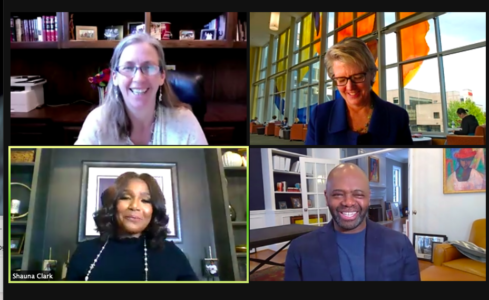Building a Diverse, Inclusive Profession

On February 2, the Center for the Legal Profession co-hosted an event (video here) with the Black Law Students Association, Women of Stanford Law, and the Stanford Center for Racial Justice that focused on how to address the scope of racial and gender inequality in the legal profession.
Moderator Joanna Grossman, a visiting professor at Stanford and professor at SMU Dedman School of Law, framed the discussion by noting that the lack of diversity and inclusion is evident in several different measures, but one of the most telling is the pyramid shape of advancement in the profession. For example, women have been 50% of law school graduates for about 20 years, but only 18% of equity partners in law firms. Lawyers of color are 22% of associates, but only 6% of equity partners. Women of color are the least represented, comprising slightly under 3% of equity partners. The lack of vertical equity is not the only way of measuring diversity or inclusion in the legal profession. Still, Grossman pointed out, it gives us a way of focusing on the persistent issue that reflects a much deeper set of problems: bias, structural inequities, complacency, power dynamics and resistance to change.
Panelists discussed the norm of lawyers being white and male, and how that affects the profession. Shauna Johnson Clark, Norton Rose Fulbright’s global and U.S. chair, as well as its head of employment and labor in the U.S., mentioned that outside of large law firms and Fortune 500 legal departments, the profession is fairly diverse. For Clark, one of the most important factors in diversifying large law firms is to create a firm culture environment that allows people to be “as close to their authentic selves as possible.”
Joseph West, a partner and Chief Diversity and Inclusion Officer at Duane Morris who previously served as the President of the Minority Corporate Counsel Association while in-house at Wal-Mart, emphasized the importance of implicit bias training. Such bias comes into play at different “chokepoints,” he explained, including recruiting, compensation, mentoring, and who gets what work. Clark, an African-American woman, mentioned that earlier in her career, when she was introduced to a new client, they would often say: “Where’s my lawyer?” She dubbed this phenomenon “sticker shock.”
Sandra Simkins. the Director and co-founder of the Children’s Justice Clinic at Rutgers Law School, argued that the norm of a female lawyer in many areas of public-interest law was itself a problem and comes with its own unique set of challenges. She pointed out that any profession that is primarily staffed with women becomes a “pink ghetto” (the subject of her recent article) with lower status and less compensation. In Simkins’ view, the gender stratification for women in public interest begins in law schools, as clinicians and legal writing professors (both primarily women), are at the lower end of the law school hierarchy.
The panelists discussed the opportunities associated with in-house counsel making diversity a priority in their hiring of outside counsel. “Client demands drive everything,” as West put it. And he said that GCs at a range of companies were starting to prioritize diversity and inclusion. Doing this meaningfully, West pointed out, means making sure that the diverse partners who own the client relationship are getting the “origination credit” for firm compensation purposes. Another approach – used by former GC Brad Smith at Microsoft – is incentivizing in-house counsel to reach diversity and inclusion metrics by tying a portion of their bonus to such goals. Clark noted that if we want to see real change, then corporate clients need to give diverse lawyers “at-bats” to run a deal or try a case. “Greatness — performing and delivering results – is the great equalizer. The problem is giving people an opportunity to be great,” she said.
The legal profession also needs to focus more on data and metrics, according to the panelists, in order to make real progress on diversity. Clark challenged law firms on this score: “In terms of making progress, if you are ashamed to even measure it, then that just speaks to the problem.” But the data challenge is even worse outside the world of large law firms. For years, the ABA has marked women’s progress in firms and other areas, Simkins pointed out, but there have been no reports or attempts to document women’s public interest careers. Grossman pointed to the continued importance of data collection from professional affinity groups like the ABA Commission on Women in the Profession and West’s former organization, the MCCA, which collaborated on the well-regarded “bias interrupters” study.
West noted greater attention in law schools to the issues around diversity and inclusion as well. Recently, there have been roundtable discussions hosted by the ABA Council on Legal Education about whether or not bias training should be mandatory in law school. “There is a greater understanding of the need for fluency around diversity and inclusion and equity, particularly as it relates to bias, and I don’t think that’s going to change,” he said.
Post Pagination
